
- Home
- The Decline of Eels
- About Me
- At Work
- The Films
- Pine Feroda
- Artworks
- Exhibitions
- The Studio & Garden
- Contact Me

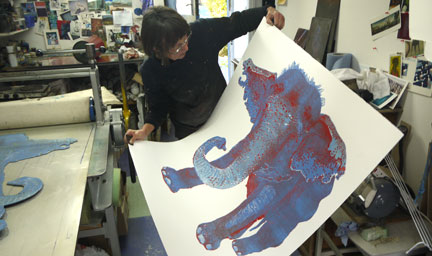
Working at my beautiful and spacious studio which is hidden away in a corner of my courtyard, I employ a variety of printing techniques. My large press allows me to print plates up to 150 x 100cm in size which gives plenty of scope; I can print thick planks of wood through to copper etching plates, and this allows me to combine relief and intaglio processes within the same print.
I make woodcuts using plywood or large planks of coarse wood that brings an element of grain and direction which I often combine with linocuts to create flat, more opaque areas. I admire the diverse drawing and mark making effects you can achieve in an etching, it is a continual experimentation and very enjoyable. My plates often go in and out of the ferric chloride for weeks to obtain the effects I am after! I also regularly use collagraph techniques to give a rich, thick colour – collagraphs are a versatile process that can combine very successfully with other printing methods.
I print on Somerset Printmaking papers and I am also beginning to experiment with Japanese papers.
Daily drawing of some of the moths trapped in my garden moth trap during Lockdown!
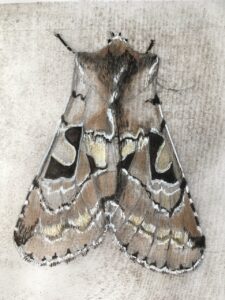
Hebrew Character
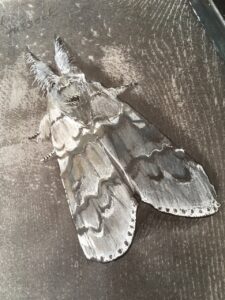
Pale Tussack
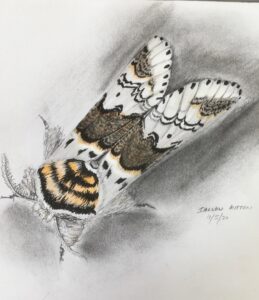
Sallow Kitten
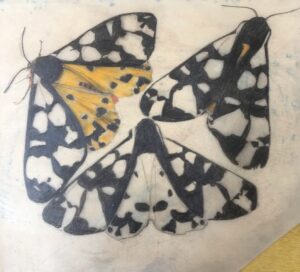
Cream Spot Garden Tigars
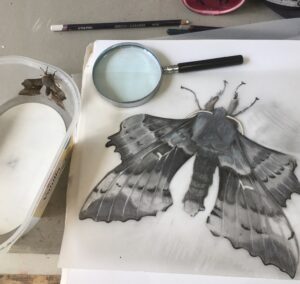
Poplar Hawkmoth
See a short film showing Julia creating a woodcut in her studio and talking about her work. It is part of a commissioned project of ‘Artists at Work’
Click here!
Taken from: Royal Society of Painter Printmakers
What is an original print:An original print is an image transferred (though not necessarily) to paper from a surface such as stone, wood or metal on which the artist has worked to produce the basic matrix. The artist makes this with the intention of producing prints and it is these, rather than the block or plate from which they are printed, that are the original works of art. Some computer-generated images may also qualify as original prints.
There is a clear distinction between images which are conceived from the outset as prints – artists’ original prints – and those which simply reproduce images first conceived in another medium. Sometimes, an artist will independently undertake the whole process from idea to completion; sometimes he or she may enlist the collaboration of a master printer; but always, the concept is the artist’s and the essential control remains with the artist from the beginning of the process to the signing of the scrupulously limited edition.
The techniques used by artist-printmakers are many. Often, they are not easy to classify because different techniques may be used in combination and individual artists often devise their own unorthodox ways of achieving their creative ends.
Intaglio Prints (the term derives from the Italian intagliare, to carve into) are made from an image cut or bitten with acid into a metal plate. A heavy ink is applied to the plate’s surface and simultaneously wiped into its furrows. The surface is then wiped clean and, as for all intaglio prints, the image is transferred from the ink-filled furrows onto dampened paper in a rolling press. The inked lines and textures of the print will be in relief and the plate will leave the imprint of its edges in the supple paper.
> Engraving: The image is engraved directly into the surface of a metal plate, usually of copper, with a burin or other sharp implement.
> Etching: The plate is covered with a thin acid-resistant layer of wax and the image is drawn through this with a needle to reveal traces of bare copper (or other suitable metal). Controlled biting with acid creates furrows or varying depth; the wax is removed, the furrows filled with ink, the unbitten surface wiped clean and the print taken.
> Drypoint: The image is scored into the plate’s surface with a sharp implement, the displaced metal forming a burr alongside each furrow. Both burr and furrow will hold ink to create a soft richness of line in the print.
> Aquatint: The plate is covered with a layer of resin dust which, when melted, allows acid to bite in the intervening spaces to create a grainy tone when printed. Aquatint is often combined with etching.
> Mezzotint: The whole surface of a copper plate is evenly textured with a rocker, a toothed implement. The image is created by scraping and burnishing this texture to varying degrees of smoothness to produce a full range of tones in the print.
Relief prints are from surfaces of wood, linoleum or other suitable material, cut so that the areas left in relief will print the image. These areas are then inked and transferred, usually to paper, either by hand or by a press with vertical pressure.
> Woodcut: Knives, gouges (and sometimes electric routers) are used to make incisions into the side grain of the block.
> Wood Engraving: This differs from woodcut in that the incisions are made with fine engraving tools in the end grain of a block of hard wood with a smoothed surface that makes delicate detail possible.
> Linocut: This, a 20th-century descendent of the woodcut, is an engraving on linoleum (or sometimes vinyl). One popular way of using the medium is the reduction method of colour printing; that is, the artist uses a single block to produce the whole multi-coloured edition, cutting away progressively and printing each stage, one on top of the other, in a different colour until the image is complete.
> Collagraph: A print taken from a collaged plate or block which may be inked by the relief and/or intaglio method. Carborundum grit mixed with glue is often applied to provide a tooth for the printing ink. There are wide possibilities for combining collagraph with other techniques – etching for instance.